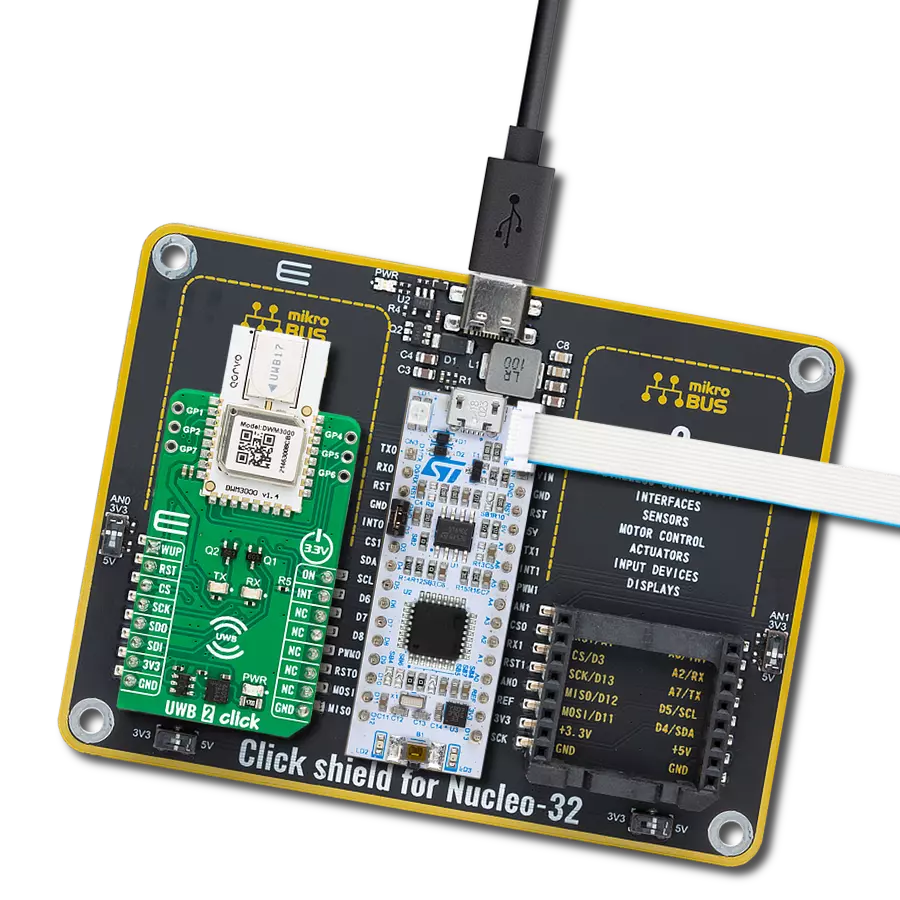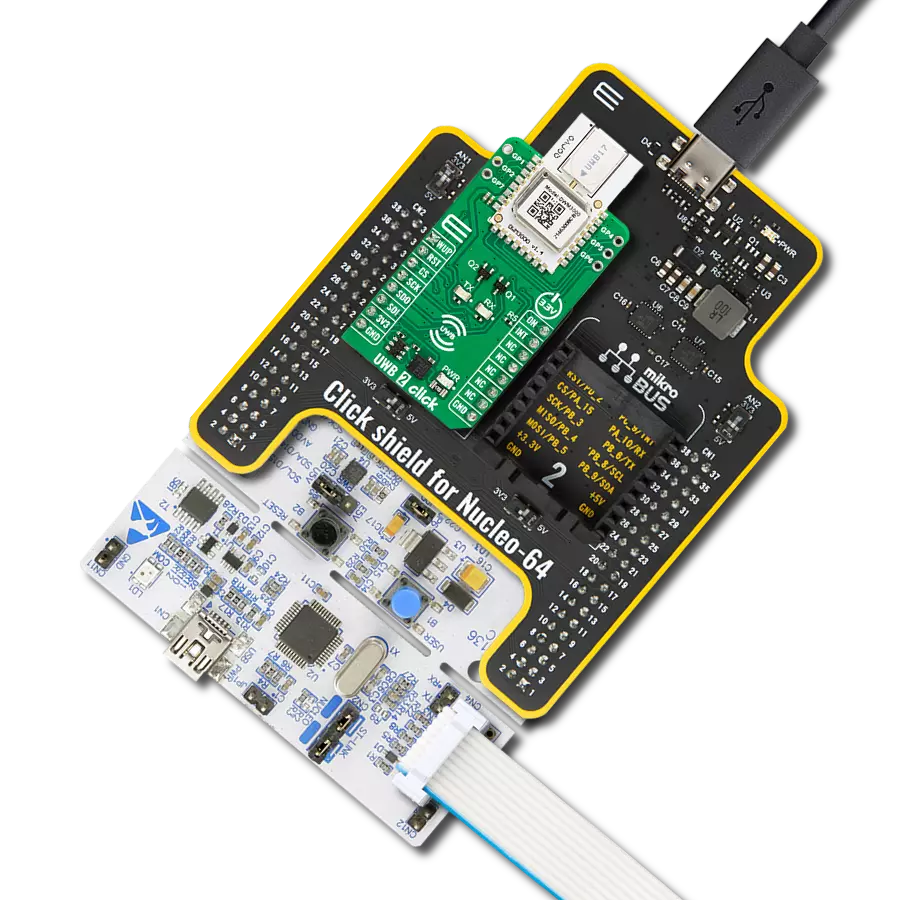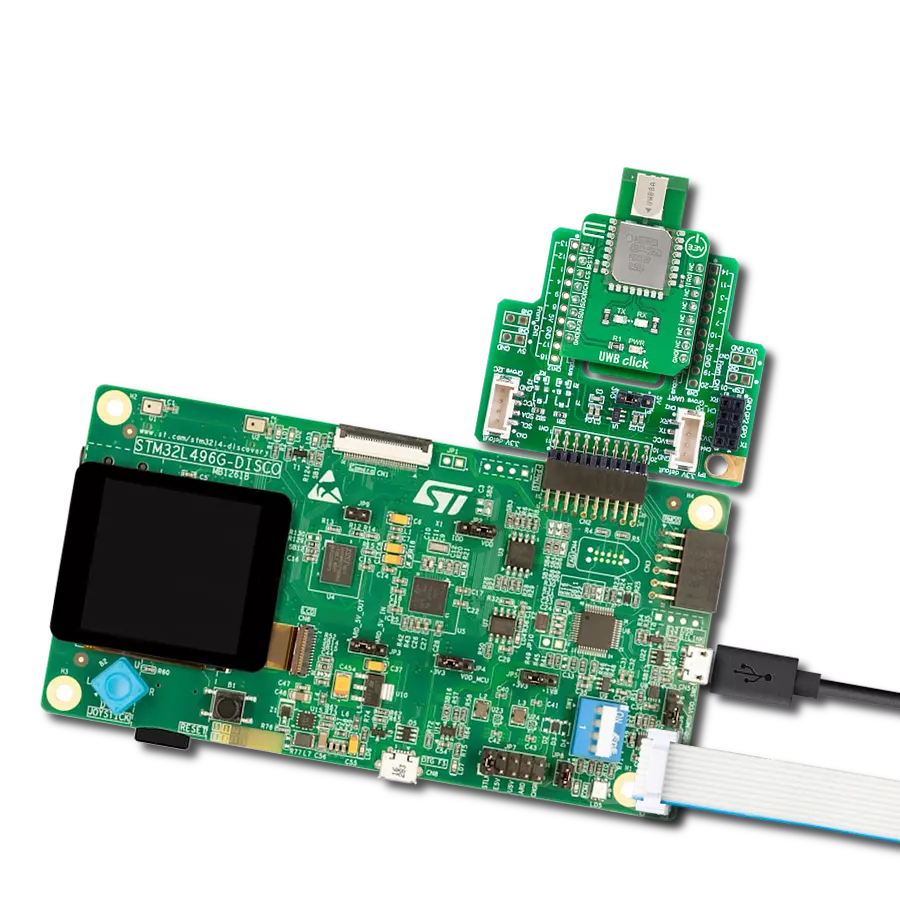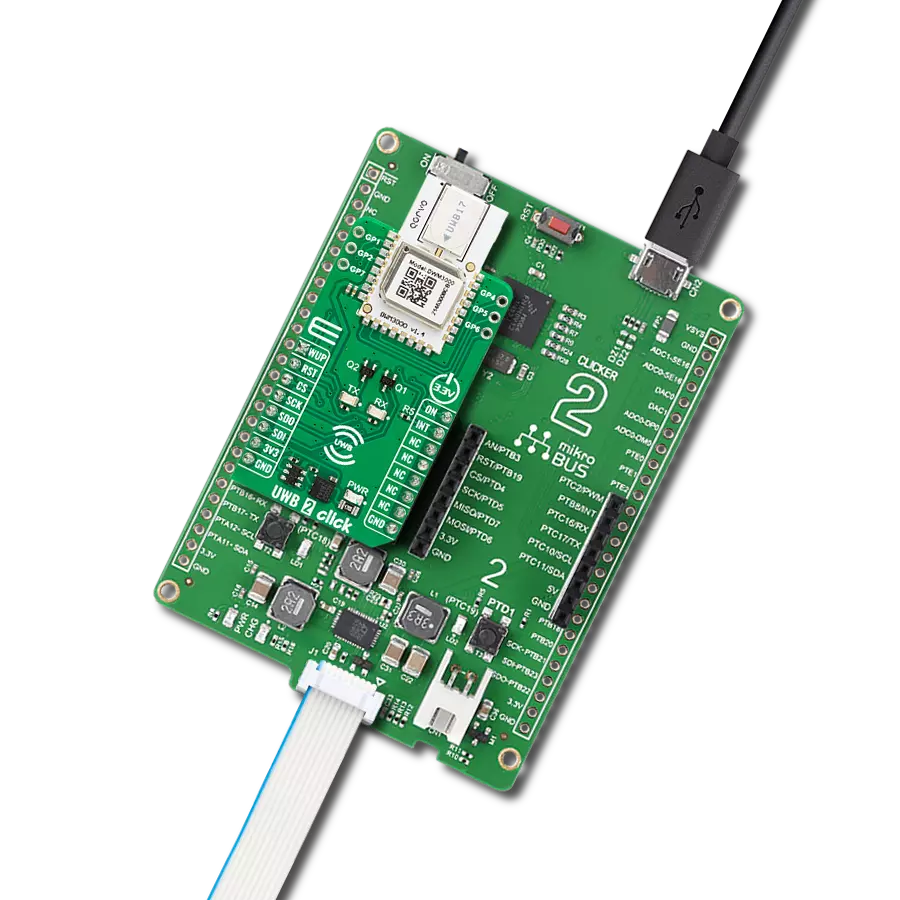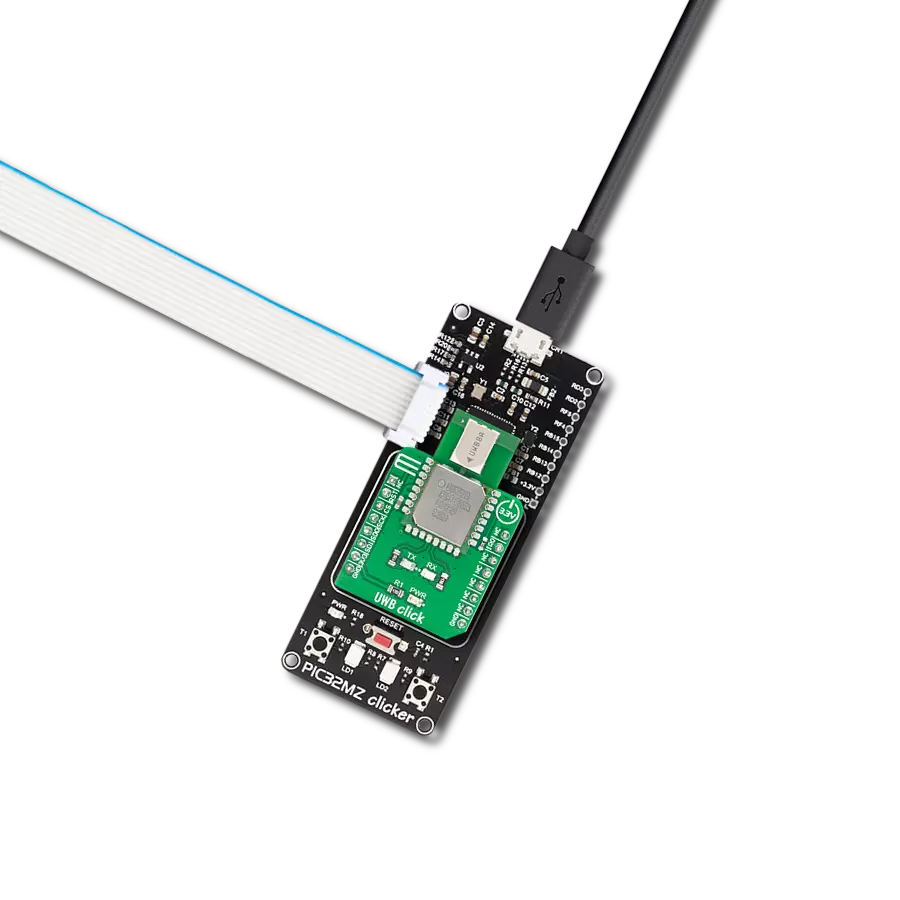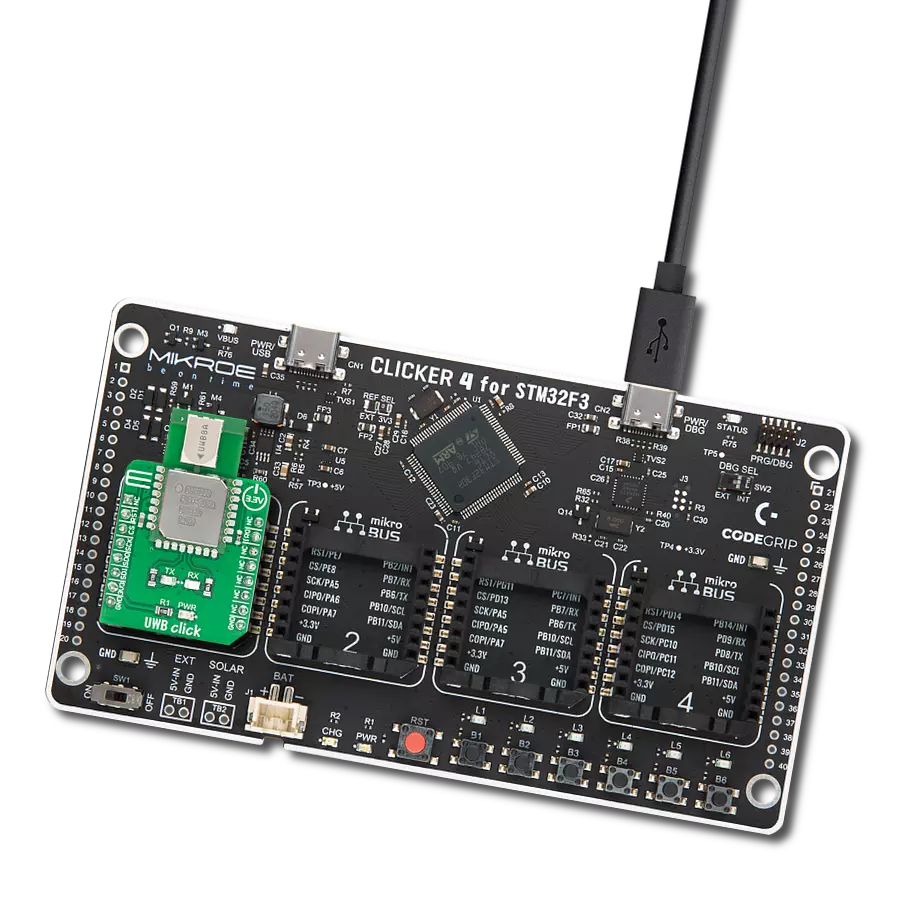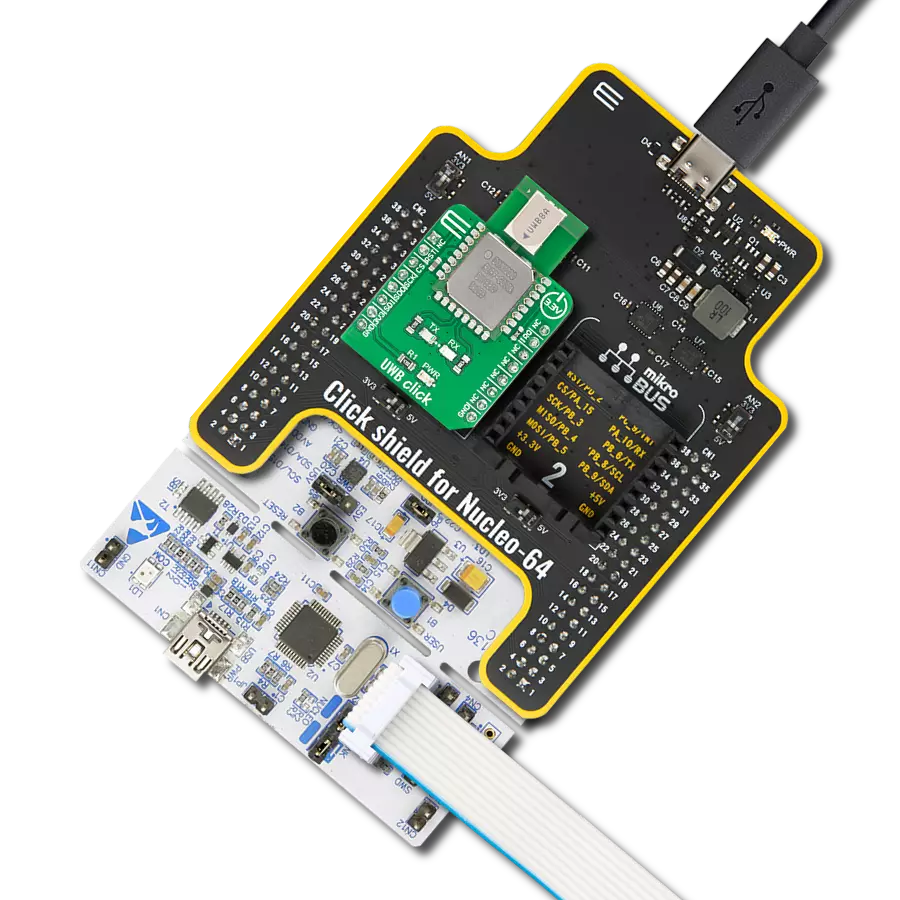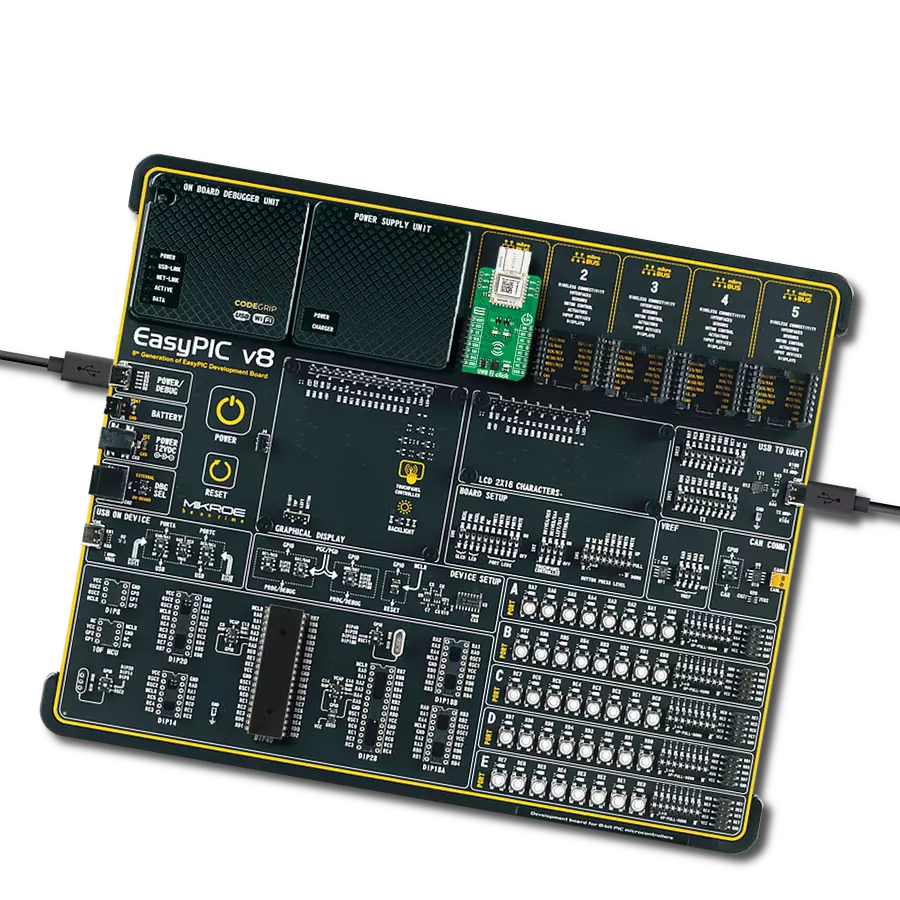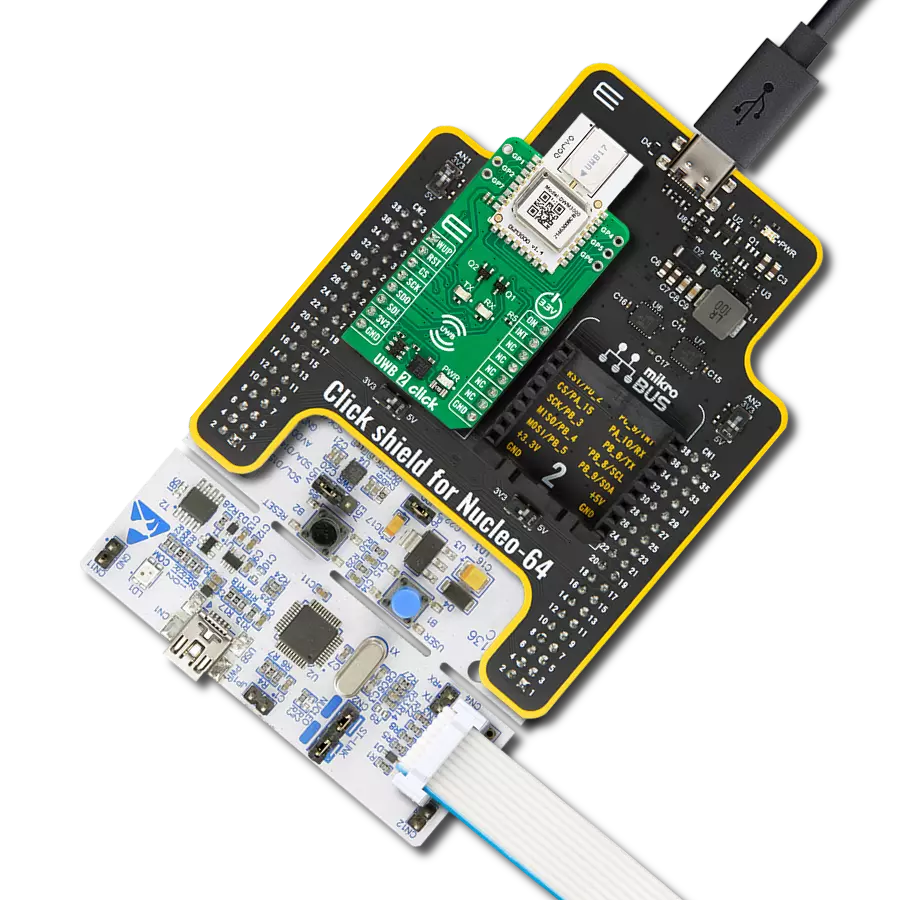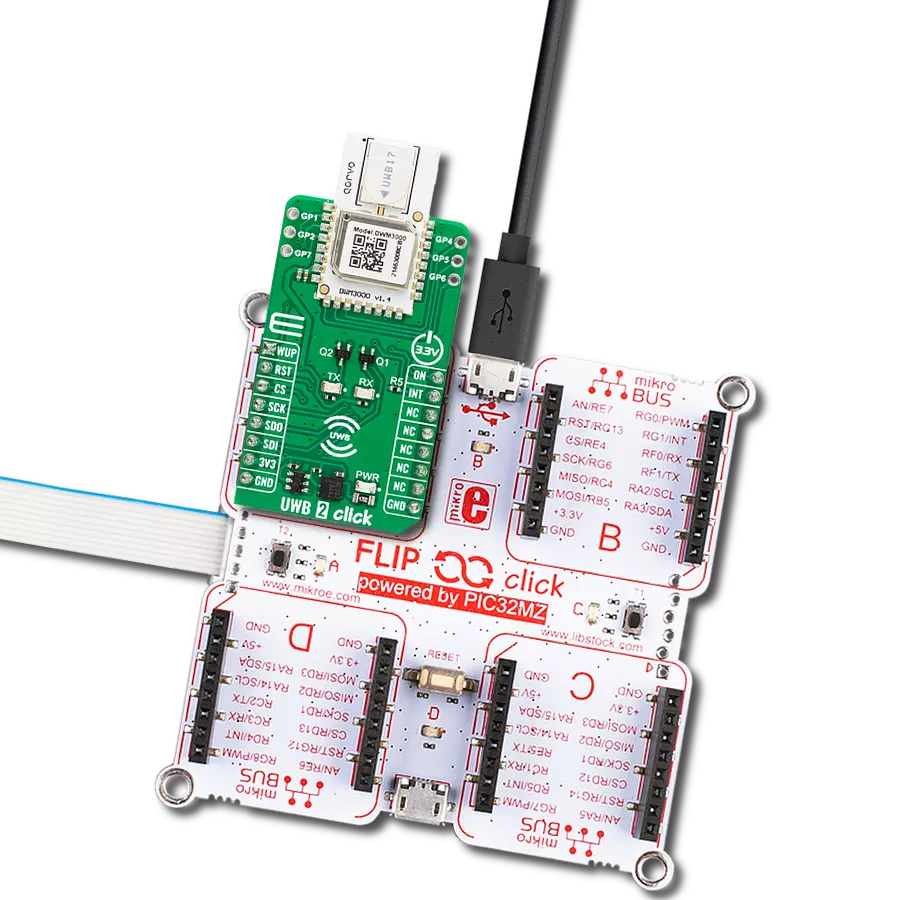它对于创建需要精确位置跟踪的系统非常有用,比如实时跟踪物体或设备的位置。
A
A
硬件概览
它是如何工作的?
UWB 3 Click基于Qorvo的DWM3001,这是一款完全集成的UWB收发器模块。该模块可用于双向测距和TDoA应用。它设计符合FiRa™ PHY和MAC规范,使其能与其他符合FiRa™标准的设备实现互操作性。它支持通道5(6.5GHz)和通道9(8GHz),数据速率可达850Kbps至6.8Mbps,适用于高数据吞吐量应用,最大数据包长度为1023字节。除了平面UWB印刷天线外,还有一个蓝牙芯片天线,用于基于Nordic Cortex-M4 32位MCU的板载设备,时钟速度为64MHz,用于利用BLE无线电收发器。这个Nordic MCU是模块的核心。nRF52833具有高级的片上接口,例如NFC-A和
USB 2.0(全速12Mbps),在UWB 3 Click中以USB C形式提供。DWM3001 UWB收发器还集成了LIS12DH,一款来自STMicroelectronics的低功耗三轴线性加速度计。由于RTLS标签通常使用加速度计在标签移动时启动UWB测距,因此可以通过默认保持在最低功耗模式下来延长电池寿命。可以通过在TP1和TP2引脚上添加NFC天线来使用近场通信类型2(NFC-A)。UWB 3 Click可以使用nRF52833的标准2-Wire UART接口与主机MCU通信,常用的UART RX和TX引脚以及波特率为115200bps。还有RX和TX LED用于可视化数据流。它还可以在32MHz上使用4-Wire SPI串行接口
进行通信。除了与Nordic MCU的通信外,I2C接口还允许您读取加速度计的数据。值得注意的是,当前的模块固件不支持SPI和I2C串行接口;这些接口保留用于将来使用。您可以通过RST引脚或RESET按钮重置模块。nRF52833固件可以通过SWDIO 6针连接器进行更新。此Click board™只能使用3.3V逻辑电压电平运行。在使用具有不同逻辑电平的MCU之前,板子必须执行适当的逻辑电压电平转换。此外,该Click board™配备有一个包含易于使用的函数和示例代码的库,可用作进一步开发的参考。
功能概述
开发板
EasyPIC v8 是一款专为快速开发嵌入式应用的需求而特别设计的开发板。它支持许多高引脚计数的8位PIC微控制器,来自Microchip,无论它们的引脚数量如何,并且具有一系列独特功能,例如首次集成的调试器/程序员。开发板布局合理,设计周到,使得最终用户可以在一个地方找到所有必要的元素,如开关、按钮、指示灯、连接器等。得益于创新的制造技术,EasyPIC v8 提供了流畅而沉浸式的工作体验,允许在任何情况下、任何地方、任何时候都能访问。
EasyPIC v8 开发板的每个部分都包含了使同一板块运行最高效的必要组件。除了先进的集成CODEGRIP程 序/调试模块,该模块提供许多有价值的编程/调试选项和与Mikroe软件环境的无缝集成外,该板还包括一个干净且调节过的开发板电源供应模块。它可以使用广泛的外部电源,包括电池、外部12V电源供应和通过USB Type-C(USB-C)连接器的电源。通信选项如USB-UART、USB DEVICE和CAN也包括在内,包括 广受好评的mikroBUS™标准、两种显示选项(图形和
基于字符的LCD)和几种不同的DIP插座。这些插座覆盖了从最小的只有八个至四十个引脚的8位PIC MCU的广泛范围。EasyPIC v8 是Mikroe快速开发生态系统的一个组成部分。它由Mikroe软件工具原生支持,得益于大量不同的Click板™(超过一千块板),其数量每天都在增长,它涵盖了原型制作和开发的许多方面。
微控制器概述
MCU卡片 / MCU
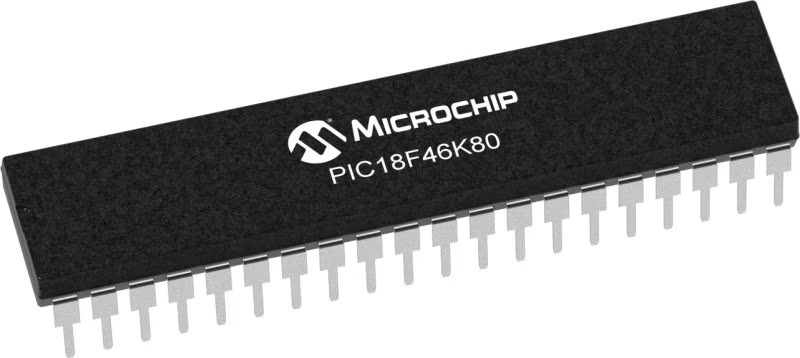
建筑
PIC
MCU 内存 (KB)
64
硅供应商
Microchip
引脚数
40
RAM (字节)
3648
使用的MCU引脚
mikroBUS™映射器
“仔细看看!”
Click board™ 原理图

一步一步来
项目组装
软件支持
库描述
该库包含 UWB 3 Click 驱动程序的 API。
关键功能:
uwb3_send_cmd- 此函数向 Click 模块发送指定的命令。uwb3_send_cmd_with_parameter- 此函数向 Click 模块发送带有指定参数的命令。uwb3_reset_device- 此函数通过切换 RST 引脚状态来重置设备。
开源
代码示例
完整的应用程序代码和一个现成的项目可以通过NECTO Studio包管理器直接安装到NECTO Studio。 应用程序代码也可以在MIKROE的GitHub账户中找到。
/*!
* @file main.c
* @brief UWB 3 Click Example.
*
* # Description
* This example demonstrates the use of an UWB 3 Click board by showing
* the communication between the two Click boards.
*
* The demo application is composed of two sections :
*
* ## Application Init
* Initializes the driver and configures the Click board for the selected
* application mode.
*
* ## Application Task
* Reads and processes all incoming ranging block messages and displays them
* on the USB UART. One Click board should be configured to initiator mode and
* the others to responder 1 or 2. The initiator Click displays the address
* and distance of each responder nodes, while the responder Click boards displays
* the address and distance of the initiator Click board.
*
* ## Additional Function
* - static void uwb3_clear_app_buf ( void )
* - static void uwb3_log_app_buf ( void )
* - static err_t uwb3_process ( uwb3_t *ctx )
* - static err_t uwb3_display_response ( uwb3_t *ctx )
* - static err_t uwb3_parse_ranging_block ( void )
*
* @author Stefan Filipovic
*
*/
#include "board.h"
#include "log.h"
#include "uwb3.h"
// Demo aplication selection macros
#define APP_INITIATOR 0
#define APP_RESPONDER_1 1
#define APP_RESPONDER_2 2
#define DEMO_APP APP_INITIATOR
/** INITF/RESPF parameter list and default value
* Order Config Param Default value Description
* #1 RFRAME BPRF 4 RFRAME BRFF set as per FiRa spec:
* 4 - SP3 SFD4Z, 6 - SP3 SFD4A
* #2 RSTU slot duration 2400 Duration of the slot in RSTU time units.
* 1ms = 1200 RSTU
* #3 Block duration ms 200 Duration of the FiRa ranging block in ms
* #4 Round duration slots 25 Duration of the FiRa ranging round inside
* the block
* #5 Ranging Round usage 2 0 - Not used, 1 - SS-TWR, 2 - DS-TWR
* #6 Session ID 42 Session ID
* #7 vupper64 01:02:03:04:05:06:07:08 Eight hexadecimal numbers, represented
* static part of the STS in FiRa standard,
* Hex values separated by ":"
* #8 Multi node mode 0 0 for unicast, 1 for multi-node configuration
* #9 Round hopping 0 0 for no round hopping, 1 for round hopping
* #10 Initiator address 0 Address of FiRa Initiator, Decimal value 0-65535
* #11 Responder address 1 Address of responder or set of addresses for
* multiple responders, Decimal value 0-65535
*/
#define INITIATOR_CONFIG "4 2400 200 25 2 42 01:02:03:04:05:06:07:08 1 0 0 1 2"
#define RESPONDER_1_CONFIG "4 2400 200 25 2 42 01:02:03:04:05:06:07:08 1 0 0 1"
#define RESPONDER_2_CONFIG "4 2400 200 25 2 42 01:02:03:04:05:06:07:08 1 0 0 2"
// Application buffer size
#define APP_BUFFER_SIZE 800
#define PROCESS_BUFFER_SIZE 200
static uwb3_t uwb3;
static log_t logger;
static uint8_t app_buf[ APP_BUFFER_SIZE ] = { 0 };
static int32_t app_buf_len = 0;
/**
* @brief UWB 3 clearing application buffer.
* @details This function clears memory of application buffer and reset its length.
* @note None.
*/
static void uwb3_clear_app_buf ( void );
/**
* @brief UWB 3 log application buffer.
* @details This function logs data from application buffer to USB UART.
* @note None.
*/
static void uwb3_log_app_buf ( void );
/**
* @brief UWB 3 data reading function.
* @details This function reads data from device and concatenates data to application buffer.
* @param[in] ctx : Click context object.
* See #uwb3_t object definition for detailed explanation.
* @return @li @c 0 - Read some data.
* @li @c -1 - Nothing is read.
* See #err_t definition for detailed explanation.
* @note None.
*/
static err_t uwb3_process ( uwb3_t *ctx );
/**
* @brief UWB 3 display response function.
* @details This function reads and displays the response to previously sent command.
* @param[in] ctx : Click context object.
* See #uwb3_t object definition for detailed explanation.
* @return @li @c 0 - OK response.
* @li @c -2 - Timeout error.
* See #err_t definition for detailed explanation.
*/
static err_t uwb3_display_response ( uwb3_t *ctx );
/**
* @brief UWB 3 parse ranging block function.
* @details This function parses the ranging block results from application buffer and
* displays it to the USB UART.
* @return @li @c 0 - Ranging block data parsed successfully.
* @li @c -1 - No valid ranging block data in application buffer.
* See #err_t definition for detailed explanation.
*/
static err_t uwb3_parse_ranging_block ( void );
void application_init ( void )
{
log_cfg_t log_cfg; /**< Logger config object. */
uwb3_cfg_t uwb3_cfg; /**< Click config object. */
/**
* Logger initialization.
* Default baud rate: 115200
* Default log level: LOG_LEVEL_DEBUG
* @note If USB_UART_RX and USB_UART_TX
* are defined as HAL_PIN_NC, you will
* need to define them manually for log to work.
* See @b LOG_MAP_USB_UART macro definition for detailed explanation.
*/
LOG_MAP_USB_UART( log_cfg );
log_init( &logger, &log_cfg );
log_info( &logger, " Application Init " );
// Click initialization.
uwb3_cfg_setup( &uwb3_cfg );
UWB3_MAP_MIKROBUS( uwb3_cfg, MIKROBUS_1 );
if ( UART_ERROR == uwb3_init( &uwb3, &uwb3_cfg ) )
{
log_error( &logger, " Communication init." );
for ( ; ; );
}
// Clear buffers
uwb3_process( &uwb3 );
uwb3_clear_app_buf( );
// Switch to stop mode
uwb3_send_cmd ( &uwb3, UWB3_CMD_STOP );
uwb3_display_response ( &uwb3 );
Delay_ms ( 1000 );
#if ( DEMO_APP == APP_RESPONDER_1 )
uwb3_send_cmd_with_parameter ( &uwb3, UWB3_CMD_RESPF, RESPONDER_1_CONFIG );
uwb3_display_response ( &uwb3 );
log_printf( &logger, "Application Mode: Responder 1\r\n" );
#elif ( DEMO_APP == APP_RESPONDER_2 )
uwb3_send_cmd_with_parameter ( &uwb3, UWB3_CMD_RESPF, RESPONDER_2_CONFIG );
uwb3_display_response ( &uwb3 );
log_printf( &logger, "Application Mode: Responder 2\r\n" );
#else
uwb3_send_cmd_with_parameter ( &uwb3, UWB3_CMD_INITF, INITIATOR_CONFIG );
uwb3_display_response ( &uwb3 );
log_printf( &logger, "Application Mode: Initiator\r\n" );
#endif
uwb3_clear_app_buf( );
log_info( &logger, " Application Task " );
}
void application_task ( void )
{
if ( UWB3_OK == uwb3_process( &uwb3 ) )
{
if ( UWB3_OK == uwb3_parse_ranging_block ( ) )
{
uwb3_clear_app_buf( );
}
}
}
int main ( void )
{
/* Do not remove this line or clock might not be set correctly. */
#ifdef PREINIT_SUPPORTED
preinit();
#endif
application_init( );
for ( ; ; )
{
application_task( );
}
return 0;
}
static void uwb3_clear_app_buf ( void )
{
memset( app_buf, 0, app_buf_len );
app_buf_len = 0;
}
static void uwb3_log_app_buf ( void )
{
for ( int32_t buf_cnt = 0; buf_cnt < app_buf_len; buf_cnt++ )
{
log_printf( &logger, "%c", app_buf[ buf_cnt ] );
}
}
static err_t uwb3_process ( uwb3_t *ctx )
{
uint8_t rx_buf[ PROCESS_BUFFER_SIZE ] = { 0 };
int32_t overflow_bytes = 0;
int32_t rx_cnt = 0;
int32_t rx_size = uwb3_generic_read( ctx, rx_buf, PROCESS_BUFFER_SIZE );
if ( ( rx_size > 0 ) && ( rx_size <= APP_BUFFER_SIZE ) )
{
if ( ( app_buf_len + rx_size ) > APP_BUFFER_SIZE )
{
overflow_bytes = ( app_buf_len + rx_size ) - APP_BUFFER_SIZE;
app_buf_len = APP_BUFFER_SIZE - rx_size;
memmove ( app_buf, &app_buf[ overflow_bytes ], app_buf_len );
memset ( &app_buf[ app_buf_len ], 0, overflow_bytes );
}
for ( rx_cnt = 0; rx_cnt < rx_size; rx_cnt++ )
{
if ( rx_buf[ rx_cnt ] )
{
app_buf[ app_buf_len++ ] = rx_buf[ rx_cnt ];
}
}
return UWB3_OK;
}
return UWB3_ERROR;
}
static err_t uwb3_display_response ( uwb3_t *ctx )
{
uint32_t timeout_cnt = 0;
uint32_t timeout = 10000;
uwb3_clear_app_buf( );
uwb3_process( ctx );
while ( ( 0 == strstr( app_buf, UWB3_RSP_OK ) ) &&
( 0 == strstr( app_buf, UWB3_RSP_ERROR ) ) )
{
uwb3_process( ctx );
if ( timeout_cnt++ > timeout )
{
uwb3_clear_app_buf( );
log_error( &logger, " Timeout!" );
return UWB3_ERROR_TIMEOUT;
}
Delay_ms ( 1 );
}
Delay_ms ( 100 );
uwb3_process( ctx );
uwb3_log_app_buf ( );
log_printf( &logger, "--------------------------\r\n" );
return UWB3_OK;
}
static err_t uwb3_parse_ranging_block ( void )
{
uint8_t * __generic_ptr start_block_ptr = NULL;
uint8_t * __generic_ptr end_block_ptr = NULL;
uint8_t * __generic_ptr results_ptr = NULL;
start_block_ptr = &app_buf[ 0 ];
for ( ; ; )
{
start_block_ptr = strstr( start_block_ptr, "\"Block\"" );
if ( !start_block_ptr )
{
return UWB3_ERROR;
}
end_block_ptr = strstr( start_block_ptr, "\r\n" );
if ( !end_block_ptr )
{
return UWB3_ERROR;
}
results_ptr = strstr( start_block_ptr, "\"Status\":\"Ok\"" );
if ( results_ptr && ( ( uint32_t ) results_ptr < ( uint32_t ) end_block_ptr ) )
{
log_printf( &logger, "######### " );
while ( ',' != *start_block_ptr )
{
log_printf( &logger, "%c", *start_block_ptr );
start_block_ptr++;
}
log_printf( &logger, " #########\r\n\n" );
while ( results_ptr && ( ( uint32_t ) results_ptr < ( uint32_t ) end_block_ptr ) )
{
// Display node address
results_ptr -= 16;
while ( ',' != *results_ptr )
{
log_printf( &logger, "%c", *results_ptr );
results_ptr++;
}
log_printf( &logger, "\r\n" );
// Display node distance
results_ptr = strstr( results_ptr, "\"D_cm\"" );
while ( ',' != *results_ptr )
{
log_printf( &logger, "%c", *results_ptr );
results_ptr++;
}
log_printf( &logger, "\r\n\n" );
results_ptr = strstr( results_ptr, "\"Status\":\"Ok\"" );
}
return UWB3_OK;
}
start_block_ptr = end_block_ptr;
}
}
// ------------------------------------------------------------------------ END





















